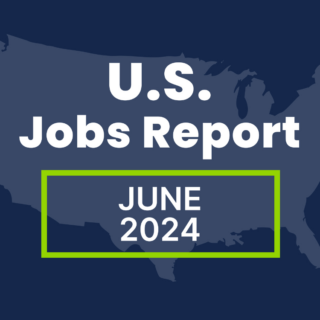Rick Betori’s role as PeopleScout’s managing director of the Americas has a few similarities with a previous leadership position he held as coach of his children’s baseball teams.
“The ball is always going to roll in between someone’s legs,” he told me from his home in the Chicago suburbs. “And, it’s not about the fact that it went through their legs; it’s what they do after and how they respond when things don’t go according to plan. That’s one of the most important things I can do in my role as a leader.”
Rick thrives when there’s a challenge to tackle, when there’s a problem to solve and when there’s the opportunity to connect the right person with the right job in a difficult labor market. It’s an important quality as employers face a talent landscape that has been transformed by the pandemic.
Although Rick joined PeopleScout in 2021, he has been a part of the TrueBlue organization since 2011, most recently leading delivery operations at PeopleReady, where he helped spearhead the company’s digital transformation. As such, he understands how technology, combined with human expertise, can solve the toughest talent problems. We talked to him about the role of talent technology in 2022.
You’re not new to TrueBlue, but you are a relatively new face here at PeopleScout. What makes you really excited about talent acquisition right now?
I’m excited because I believe that we can truly help companies that are facing some of their largest hiring challenges in their histories. Talent acquisition teams need creative partners to help them succeed, and I’m thrilled to be a part of finding those solutions.
I’m also passionate about our talent technology platform, Affinix™, and what it does to help candidates seamlessly move through the application process. Candidates have so many choices today; when they’re searching for a new role, they expect a great experience, and they want it to be fast. I also think that now more than ever, data and analytics will be key in helping employers stay ahead of their competition in a difficult talent market.
And finally, I’ve been a part of the TrueBlue family since 2011, so I’ve been able to witness the passion and energy of the PeopleScout team working to put our clients first. It’s been great to dig in with the team in these last few months. They bring this infectious energy to do what’s right for our clients and their applicants. I’m proud to be a part of this organization moving forward.
Throughout the last couple of years, we’ve seen a lot of employers add technology to their recruitment process out of need. For talent acquisition leaders, where do you think their relationship with talent technology stands today?
I hate to start the answer to a question with “it depends,” but it really does vary. We have seen many employers add technology solutions to deal with increased workload, compliance concerns, and to eliminate or simplify administrative tasks.
More recently, employers feel the pressures of attracting top talent, so they’re taking the next step, focusing on easing and improving the process for candidates. More companies are starting to leverage technology to reduce friction for candidates in the application process and at the same time, building a stronger employer brand.
Finally, we’re seeing leaders stepping back and asking, “How can technology, data and analytics inform our decision-making from a talent standpoint?” These leaders want more information around changes in roles; how the market is responding in their specific area; and how factors like the rise of the gig economy and the COVID-19 pandemic have influenced their prospective talent pools.
The right technology can really make the recruitment process feel even more personal and enhance an organization’s employer brand. How can you make that happen?
It’s about more than the right technology; it’s about the right technology at the right time. Employers can make the greatest impact by targeting specific points in the candidate’s journey.
For example, we know that candidates want to feel a sense of control in the process, and they want to feel as though things are moving forward. That means employers need to keep candidates feeling engaged and empowered. So, the right technology intervention could be implementing a pre-screen that candidates can complete by text or adding an interview self-scheduling tool. These give candidates the ability to feel like they’re taking the next step in the process, rather than waiting to hear back from someone.
Employers should also evaluate specific tools to ensure they fit with their brand. For example, candidates applying to a technology company would expect the process to include more advanced technology, more automation and a more cutting-edge approach to the recruitment process. On the other hand, candidates for positions where the work is focused on manual tasks or face-to-face interactions may expect a different experience. It’s not one size fits all.
Why should employers reevaluate their technology stacks now?
In the current market, talent acquisition teams need to move faster than ever to identify and secure talent. The days of long recruitment processes, multiple interviews and multiple steps are over.
Candidates have so many opportunities facing them today…and it’s not just different employers. Think about the impact of virtual work. It used to be that companies simply competed with other organizations in their area, but now, they compete for top talent with companies across the globe.
Add that to that the fact that many employers are reporting a record numbers of job openings and they can’t ramp up their internal teams fast enough to keep up with the number of requisitions they’ve got to fill. The right tools, and the right partner, can make the process easier and even provide them a competitive advantage.
Adding new technology to an established process can be scary. What advice do you have for talent leaders to help them gain buy-in in their organizations?
First off, I’d say, if there wasn’t any fear, I’d be surprised. It’s human nature. But that’s not a reason not to automate.
It starts with having a good, strong, proactive communication plan around the process—explaining what they’re doing and why they’re doing it. It should be transparent and easy to understand. The plan should clearly demonstrate the benefits for the team, and then, it’s important to gather feedback. There must be open lines of communication. It’s about letting people weigh in as you fine-tune the process. Finally, it’s great to recognize and celebrate the early adopters. We’ve seen a lot of success in highlighting the employees who engage and really embrace the change early on.
With internal buy-in, it’s tough, and you can’t underestimate the challenge. However, a good, solid plan executed by leadership goes a long way.
Are there any final thoughts you’d like to leave us with?
I want to put an exclamation point on something I said earlier about the importance of speed in the current talent market. I know the types of pressures that talent leaders are under right now. I don’t have a crystal ball to tell you how long it will last, but I can say that when you find the right partner, they can help you start this process in a way that feels manageable, and that can also help you prepare for whatever challenge lies ahead.


